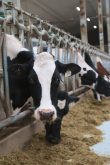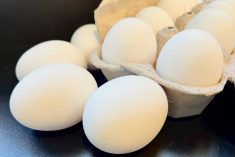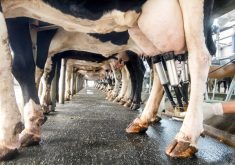What do you get when you mix milk and eggs with a looming election? A “free” trade deal that gained major market access in Asia for Canada, but managed to keeps the tariffs for Canada’s supply-managed commodities.
After all the barking from New Zealand, cows parading on Parliament Hill, tweets, heart-wrenching videos on Facebook, election grandstanding and even a dramatic last-minute delay, a deal in principle was reached Oct. 5 between the 12 participating countries of the Trans-Pacific Partnership, including Canada.
In the end, Canada’s milk, chicken, turkey and egg industries gave up a little foreign access, in exchange for maintaining the current tariffs on imports.
Read Also

Alberta crop conditions improve: report
Varied precipitation and warm temperatures were generally beneficial for crop development across Alberta during the week ended July 8, according to the latest provincial crop report released July 11.
According to government officials, this agreement should smooth the way for economic growth for the next couple of decades, including significant increases in access to the lucrative Japanese market for beef, pork, canola and wheat.
Many supply-managed farmers, however, were expecting to wake up that Monday morning and be forced to face a future in which they don’t have the scale to compete.
“The amount of chicken the U.S. produces in two weeks would fill our entire market for a whole year,” says chicken farmer Murray Opsteen of Flamborough, Ont. “We need this protection.”
Under both the Canada-EU CETA (Comprehensive Economic and Trade Agreement) and the TPP agreement, the three pillars of the supply management system will remain protected: domestic volume control, producer pricing (formula) and import controls (tariffs and access).
However, under the terms of the TPP agreement, these domestic supply markets did take a hit, with an increase in the amount of foreign access.
The total access to Canadian markets increased by the equivalent of 3.25 per cent of Canada’s 2016 milk production, 2.3 per cent for eggs, 2.1 per cent for chicken, two per cent for turkey and 1.5 per cent for broiler hatching eggs. The actual access in the agreement is measured in production units — for example, foreign access for chicken will increase by 385,000 kilograms per year.
Tariffs for these products are here to stay — at least for the duration of the deal.
This additional access is to be granted through tariff rate quotas (TRQs) phased in over five years once the TPP agreement comes into force, and is in addition to access already provided under existing free trade agreements.
“Canada will provide permanent TPP-wide TRQs covering all supply-managed products, such as cheese, butter, yogurt, fluid milk, poultry and eggs,” says Patrick Girard, Agriculture and Agri-Food Canada’s senior media relations officer.
With the TPP agreement come assurances for more set federal standards, which are expected to help close some border loopholes and leaks. These include addressing the importations of mozzarella cheese and spent fowl.
Adjusting to change
The TPP has to be ratified through each country’s Parliament, including Canada’s. All three main federal parties publicly support supply management. The biggest stumbling block for the TPP could be getting it through the U.S. Congress before the presidential election heats up too much.
In Canada, this high-octane election topic was kept closely under wraps. It doesn’t seem to be a gateway agreement to end supply management, but rather a generational commitment, says Chicken Farmers of Canada’s executive director Mike Dungate, who was in a lockdown room as details of the negotiations came in.
Obviously, the transition support programs were premeditated long before the announcement, as AAFC introduced them simultaneously with the agreement.
AAFC’s $4.3 billion in olive branches to compensate for the added access and loss of domestic market include a Income Guarantee Program of payments to each quota holder upfront annually, for a full 10 years from the day TPP comes into force and on a tapered basis for an additional five years.
Need does not have to be proven to get an Income Guarantee cheque. The estimated compensation under the $2.4 billion program over the full 15-year period for, say, an average dairy farmer is expected to be about $165,000 to cover losses in access.
Such calculations are based on expected domestic production levels, under conditions with a TPP agreement and the Canada-EU CETA in place, relative to prices and production without these agreements. A model will take into account detailed historic economic and farm-level data, projected into the future, Girard says.
‘Industry dynamics’
Also in the package, AAFC announced a Quota Value Guarantee program. Farmers who sell quota after TPP comes into force will be eligible to receive payments under the Quota Value Guarantee program. Another $1.5 billion has been set aside for this demand-driven program, which will be in place for 10 years.
Nothing in this agreement should affect quota values when quota is traded freely and based on increase in margins and production, CFC’s Dungate says. Dairy quotas are more quantifiable and controllable, however, because they go through board exchanges.
“Quota values (for chicken) will likely be more a factor of industry dynamics,” he says.
AAFC, the Canadian Dairy Commission and the Farm Products Council of Canada are to work with industry to develop ways to make the Quota Value Guarantee program operational, including payment calculations.
Farm Credit Canada (FCC) wouldn’t comment about the agreement before the election. Craig Bremner, vice-president of agricultural services for TD Canada Trust, said it’s business as usual for that lender.
Based on $24,000 per unit and one unit per cow, times 960,000 dairy cows, a conservative estimate of dairy quota assets is $23.04 billion — and that’s just dairy quota.
Details available so far on the programs for supply-managed producers and processors are posted on AAFC’s website.
— Maggie Van Camp is an associate editor for Country Guide at Blackstock, Ont. Follow her at @maggievancamp on Twitter.















